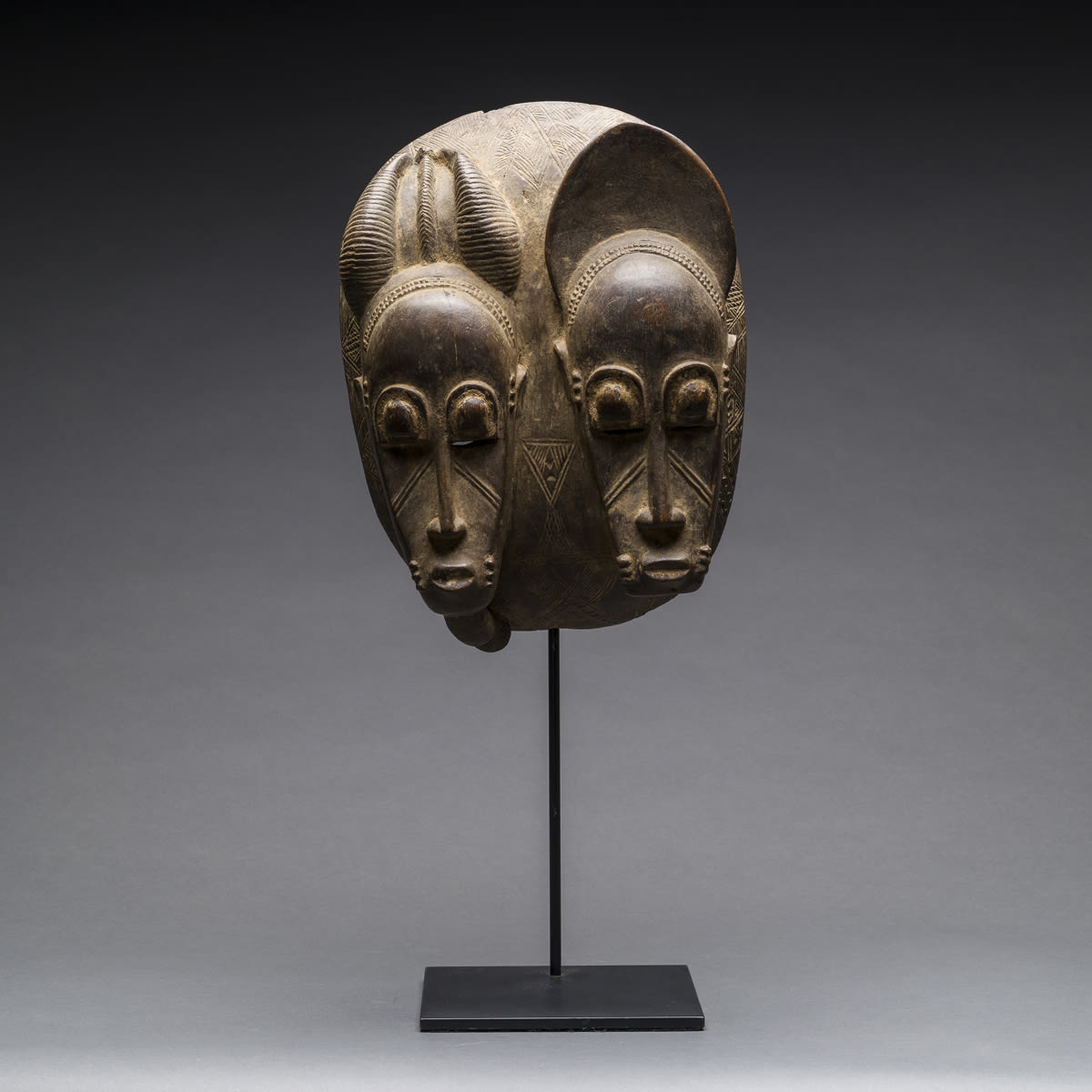Baule Bicephalous Wooden Mask, 20th Century CE
Wood
30 x 22 cm
11 3/4 x 8 5/8 in
11 3/4 x 8 5/8 in
PF.3173 (LSO)
Further images
This compact bicephalous mask was made by the Baule of the Ivory Coast area. It is in the facemask format, with piercings around the perimeter. Unusually, the heads are fully...
This compact bicephalous mask was made by the Baule of the Ivory Coast area. It is in the facemask format, with piercings around the perimeter. Unusually, the heads are fully separate. The faces are male (left) and female (right), denoted by the presence/absence of a three-section beard. The general proportions of the faces are the same, but the detailing in terms of the beard and the hairstyle is slightly different. The female mask is also slightly the taller of the two. They both have hooded slit eyes with unusual lid detailing, long inverted T-bar noses and pursed lips with triple keloid scarifications on either side. They also have twin diagonal stripes rising centrally across each cheek. The male mask has a pair of ornate horns and a central spike as coiffure, while the female has a spatulate peaked plate of hair pointing slightly forward. The coiffure in each case is separated from the forehead by a double beaded line. The body of the mask is decorated with geometric motifs (based around hatching and triangles) on each side, and centrally by incised lines and a downward-pointing triangle with internal hatching. They have a glossy surface patina, with encrusted matter on recessed portions of the features and incised engraving.
The Baule live across the Ivory Coast area, and have an economy based primarily on sedentary agriculturism. They have thus been able to build up a considerable political and economic stronghold, which has in turn given rise to a strong ritual and artistic heritage. Their own creation story relates to an ancient migration, in which the queen was forced to sacrifice her son in order to ford a mighty river. So upset was she that all she could say was baouli (the child is dead), thus giving rise to the tribe's name.
Blolo bian (male) and Blolo bla (female) spirit spouses are perhaps the Baule's greatest artistic and psycho-social achievement, but they are also renowned for sculptures representing bush spirits (Asie usu) mischievous and potentially malevolent inhabitants of the bush, or dark country beyond the boundary of the village as well as dance masks, prestige items (often made of gold) and a range of highly decorated secular objects such as doors, heddle pulleys and culinary equipment.
The fact that many such pieces have a centuries-old patina from handling and libations would seem to suggest that pieces can be inherited, and that the sculptures can either contain more than one spouse, or that s/he can be replaced by the spouse of the new owner. This is particularly the case with valuable or very well-carved pieces. Like most other human societies, the Baule are prey to conspicuous consumption, which is a central key to asserting one's status in the village, and thus one's power and influence. While their carving is among the most refined and restrained in Africa, therefore, artists vie to produce more impressive and beautiful carvings which are often decorated or adorned by their proud owners.
The function of this mask would seem to be diplomatic; more common, single-headed variants are worn to receive important dignitaries, while the rarer bicephalous masks have the added positive association of twins, which are a good omen for most African groups (notably the Yoruba). This is an attractive example, and a worthy addition to any discerning collection.
The Baule live across the Ivory Coast area, and have an economy based primarily on sedentary agriculturism. They have thus been able to build up a considerable political and economic stronghold, which has in turn given rise to a strong ritual and artistic heritage. Their own creation story relates to an ancient migration, in which the queen was forced to sacrifice her son in order to ford a mighty river. So upset was she that all she could say was baouli (the child is dead), thus giving rise to the tribe's name.
Blolo bian (male) and Blolo bla (female) spirit spouses are perhaps the Baule's greatest artistic and psycho-social achievement, but they are also renowned for sculptures representing bush spirits (Asie usu) mischievous and potentially malevolent inhabitants of the bush, or dark country beyond the boundary of the village as well as dance masks, prestige items (often made of gold) and a range of highly decorated secular objects such as doors, heddle pulleys and culinary equipment.
The fact that many such pieces have a centuries-old patina from handling and libations would seem to suggest that pieces can be inherited, and that the sculptures can either contain more than one spouse, or that s/he can be replaced by the spouse of the new owner. This is particularly the case with valuable or very well-carved pieces. Like most other human societies, the Baule are prey to conspicuous consumption, which is a central key to asserting one's status in the village, and thus one's power and influence. While their carving is among the most refined and restrained in Africa, therefore, artists vie to produce more impressive and beautiful carvings which are often decorated or adorned by their proud owners.
The function of this mask would seem to be diplomatic; more common, single-headed variants are worn to receive important dignitaries, while the rarer bicephalous masks have the added positive association of twins, which are a good omen for most African groups (notably the Yoruba). This is an attractive example, and a worthy addition to any discerning collection.





